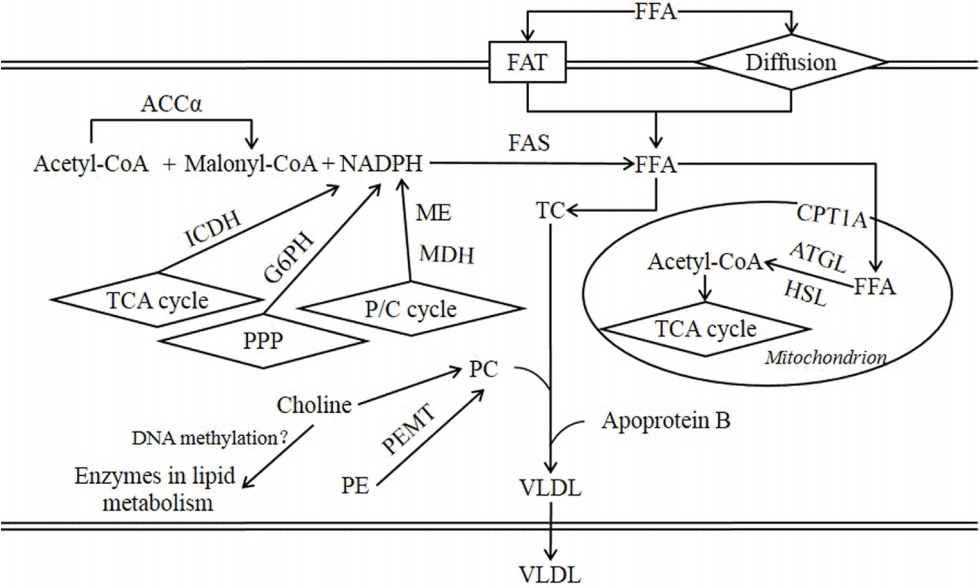1. Wang T, Huo YJ, Shi F, Xu RJ, Hutz RJ. Effects of intrauterine growth retardation on development of the gastrointestinal tract in neonatal pigs. Biol Neonate 2005; 88:66ŌĆō72.


2. Che L, Xuan Y, Hu L, et al. Effect of postnatal nutrition restriction on the oxidative status of neonates with intrauterine growth restriction in a pig model. Neonatology 2015; 107:93ŌĆō9.


4. Liu C, Lin G, Wang X, et al. Intrauterine growth restriction alters the hepatic proteome in fetal pigs. J Nutr Biochem 2013; 24:954ŌĆō9.


5. Marchesini G, Bugianesi E, Forlani G, et al. Nonalcoholic fatty liver, steatohepatitis, and the metabolic syndrome. Hepatology 2003; 37:917ŌĆō23.


6. Valsamakis G, Kanaka-gantenbein C, Malamitsi-puchner A, Mastorakos G. Causes of intrauterine growth restriction and the postnatal development of the metabolic syndrome. Ann NY Acad Sci 2006; 1092:138ŌĆō47.


7. Thamotharan M, Shin BC, Suddirikku DT, et al. Glut4 expression and subcellular localization in the intrauterine growth-restricted adult rat female offspring. Am J Physiol Endocrinol Metab 2005; 288:E935ŌĆō47.


8. Siljander-Rasi H, Peuranen S, Tiihonen K, et al. Effect of equi-molar dietary betaine and choline addition on performance, carcass quality and physiological parameters of pigs. Anim Sci 2003; 76:55ŌĆō62.

9. Sidransky H, Farber E. Liver choline oxidase activity in man and in several species of animals. Arch Biochem Biophys 1960; 87:129ŌĆō33.


10. He Q, Ren P, Kong X, et al. Intrauterine growth restriction alters the metabonome of the serum and jejunum in piglets. Mol BioSyst 2011; 7:2147ŌĆō55.


11. NRC. Nutrient requirements of poultry: National Research Council. Washington, DC, USA: National Academy Press; 1998.
12. Engel RW. Modified methods for the chemical and biological determination of choline. J Biol Chem 1942; 144:701ŌĆō10.

13. Noma A, Okabe H, Kita M. A new colorimetric micro-determination of free fatty acids in serum. Clin Chim Acta 1973; 43:317ŌĆō20.


15. Sullivan DR, Kruijswijk Z, West CE, Kohlmeier M, Katan MB. Determination of serum triglycerides by an accurate enzymatic method not affected by free glycerol. Clin Chem 1985; 31:1227ŌĆō8.


17. Huang Q, Xu Z, Han X, Li W. Effect of dietary betaine supplementation on lipogenic enzyme activities and fatty acid synthase mrna expression in finishing pigs. Anim Feed Sci Technol 2008; 140:365ŌĆō75.

18. Xi G, Xu Z, Wu SH, Chen S. Effect of chromium picolinate on growth performance, carcass characteristics, serum metabolites and metabolism of lipid in pigs. Asian-Australas J Anim Sci 2001; 14:258ŌĆō62.

19. MacDonald MJ. Differences between mouse and rat pancreatic islets: Succinate responsiveness, malic enzyme, and anaplerosis. Am J Physiol Endocrin Metabol 2002; 283:E302ŌĆō10.

20. Livak KJ, Schmittgen TD. Analysis of relative gene expression data using real-time quantitative pcr and the 2
ŌłÆ╬ö╬öCT method. Methods 2001; 25:402ŌĆō8.


21. Ueland PM. Choline and betaine in health and disease. J Inherit Metab Dis 2011; 34:3ŌĆō15.


22. Rehfeldt C, Lefaucheur L, Block J, et al. Limited and excess protein intake of pregnant gilts differently affects body composition and cellularity of skeletal muscle and subcutaneous adipose tissue of newborn and weanling piglets. Eur J Nutr 2012; 51:151ŌĆō65.


23. Attig L, Djiane J, Gertler A, et al. Study of hypothalamic leptin receptor expression in low-birth-weight piglets and effects of leptin supplementation on neonatal growth and development. Am J Physiol Endocrinol Metab 2008; 295:E1117ŌĆō25.


24. Claris O, Beltrand J, Levy-Marchal C. Consequences of intrauterine growth and early neonatal catch-up growth. Semin Perinatol 2010; 34:207ŌĆō10.


25. Taverne F, Richard C, Couture P, Lamarche B. Abdominal obesity, insulin resistance, metabolic syndrome and cholesterol homeostasis. PharmaNutrition 2013; 1:130ŌĆō6.

28. Shirakawa T, Nakajima K, Yatsuzuka S, et al. The role of circulating lipoprotein lipase and adiponectin on the particle size of remnant lipoproteins in patients with diabetes mellitus and metabolic syndrome. Clin Chim Acta 2015; 440:123ŌĆō32.


30. Turpin S, Hoy A, Brown R, et al. Adipose triacylglycerol lipase is a major regulator of hepatic lipid metabolism but not insulin sensitivity in mice. Diabetologia 2011; 54:146ŌĆō56.


32. Lane RH, Kelley DE, Gruetzmacher EM, Devaskar SU. Uteroplacental insufficiency alters hepatic fatty acid-metabolizing enzymes in juvenile and adult rats. Am J Physiol Regul Integr Comp Physiol 2001; 280:R183ŌĆō90.


33. Sachan DS, Hongu N. Increases in vo
2max and metabolic markers of fat oxidation by caffeine, carnitine, and choline supplementation in rats. J Nutr Biochem 2000; 11:521ŌĆō6.


34. Zeisel SH, Da Costa KA, Franklin PD, et al. Choline, an essential nutrient for humans. FASEB J 1991; 5:2093ŌĆō8.


35. Raubenheimer PJ, Nyirenda MJ, Walker BR. A choline-deficient diet exacerbates fatty liver but attenuates insulin resistance and glucose intolerance in mice fed a high-fat diet. Diabetes 2006; 55:2015ŌĆō20.


37. Maloney CA, Gosby AK, Phuyal JL, et al. Site-specific changes in the expression of fat-partitioning genes in weanling rats exposed to a low-protein diet in utero. Obes Res 2003; 11:461ŌĆō8.


39. Koletzko B, Shamir R. Prenatal and postnatal nutrition: impact on child health. Curr Opin Clin Nutr Metab Care 2013; 16:290ŌĆō1.











 PDF Links
PDF Links PubReader
PubReader ePub Link
ePub Link Full text via DOI
Full text via DOI Download Citation
Download Citation Print
Print





